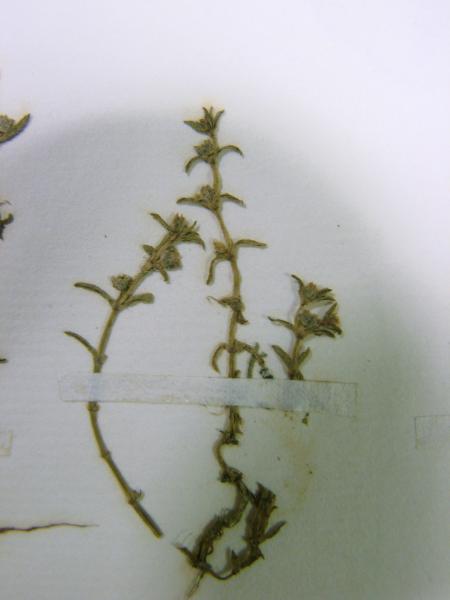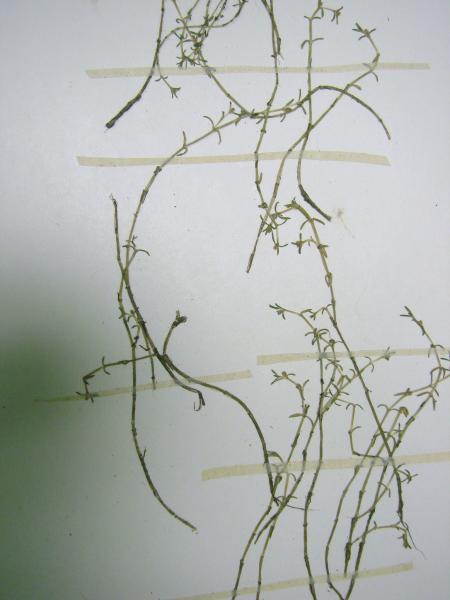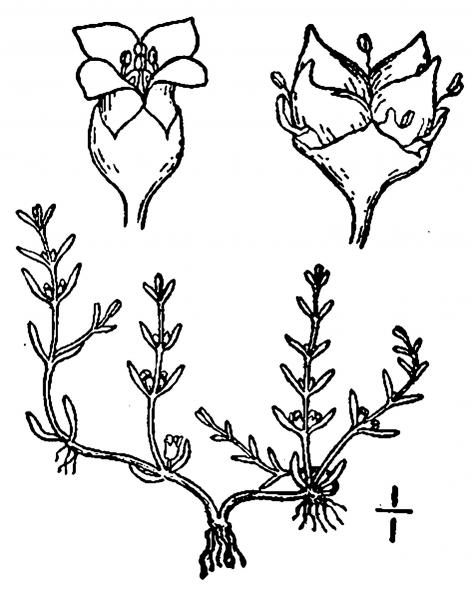Water Pigmyweed
Crassula aquatica (L.) Schoenl.
- Class
- Dicotyledoneae (Dicots)
- Family
- Crassulaceae (Stonecrop Family)
- State Protection
- Endangered
Listed as Endangered by New York State: in imminent danger of extirpation in New York. For animals, taking, importation, transportation, or possession is prohibited, except under license or permit. For plants, removal or damage without the consent of the landowner is prohibited.
- Federal Protection
- Not Listed
- State Conservation Status Rank
- S1
Critically Imperiled in New York - Especially vulnerable to disappearing from New York due to extreme rarity or other factors; typically 5 or fewer populations or locations in New York, very few individuals, very restricted range, very few remaining acres (or miles of stream), and/or very steep declines.
- Global Conservation Status Rank
- G5
Secure globally - Common in the world; widespread and abundant (but may be rare in some parts of its range).
Summary
Did you know?
Water pigmyweed is everywhere and nowhere. It is a very widespread species in the colder regions of Europe and the Western Hemisphere but it is often overlooked because it is so small, has inconspicuous flowers and lives in rarely explored aquatic habitats. In New York it is even harder to see because it occurs in freshwater tidal areas where it is only visible for a few hours each day.
State Ranking Justification
There are two large populations and one very small population which may be extirpated. There are four historical populations which need to be surveyed in more detail but they probably no longer exist.
Short-term Trends
One large population seems to be doing well but more survey work is needed at the remaining two populations to evaluate their current trend. Populations are difficult to survey because of the tidal nature of their habitat and populations could fluctuate dramatically.
Long-term Trends
This species was always very rare in New York occurring in only a few places. Two existing populations are new and one historical population has been rediscovered. The few additional historical populations have not been found.
Conservation and Management
Threats
Overuse of riverside and pond shore habitats as well as invasion of these habitats by Phragmites presents a significant threat to the survival of this species in New York.
Conservation Strategies and Management Practices
Shoreline habitats need to be protected from invasion by Phragmites and other wetland invasive species while also protecting them from overuse by boaters and trampling.
Research Needs
Research is needed to determine if current populations can be augmented by propagation and replanting.
Habitat
Habitat
In New York this species has been found in tidal mud flats, marshes, and rocky shores along the lower Hudson River, and along the banks of an intertidal river on Long Island (New York Natural Heritage Program 2007). Margins of pools and on fresh to tidal shores (Fernald 1970). Muddy shores near the coast, usually in the intertidal zone (Gleason and Cronquist 1991).
Associated Ecological Communities
- Freshwater intertidal mudflats
(guide)
A sparsely vegetated community characterized by low rosette-leaved aquatics. This community occurs on exposed intertidal mudflats where the water is fresh (salinity less than 0.5 ppt). This community is best developed where mudflats are nearly level so that broad expanses are exposed at low tide. The plants are completely submerged in 0.9 to 1.2 m (3 to 4 ft) of water at high tide and they are usually coated with mud.
- Freshwater intertidal shore
(guide)
A community of the intertidal gravelly or rocky shores of freshwater tidal rivers and creeks, sometimes occurring at the base of cliffs. The vegetation may be very sparse.
- Freshwater tidal marsh
(guide)
A marsh community that occurs in shallow bays, shoals, and at the mouth of tributaries of large tidal river systems, where the water is usually fresh (salinity less than 0.5 ppt), and less than 2 m (6 ft) deep at high tide. Typically there are two zones in a freshwater tidal marsh: a low-elevation area dominated by short, broadleaf emergents bordering mudflats or open water, and a slightly higher-elevation area dominated by tall grass-like plants.
- Riverine submerged structure
The aquatic community associated with an artificially introduced structure submerged in riverine waters, such as a stream or river, that provides habitat for fish and other organisms. This includes structures that have been intentionally sunk for the purpose of attracting fish, as well as sunken ships, disposed waste, submerged bridge abutments, or any other introduced material that provides suitable habitat.
Associated Species
- Amaranthus cannabinus (salt marsh water-hemp)
- Callitriche palustris (vernal water-starwort)
- Cardamine longii
- Gratiola neglecta (northern clammy hedge-hyssop)
- Helenium autumnale (common sneezeweed)
- Limosella australis (Atlantic mudwort)
- Lindernia dubia
- Lythrum salicaria (purple loosestrife)
- Persicaria punctata (dotted smartweed)
- Pilea fontana (black-fruited clearweed)
- Plantago maritima
- Pluchea odorata (salt marsh-fleabane)
- Pontederia cordata (pickerelweed)
- Ranunculus repens (creeping butter-cup, creeping crow-foot)
- Sagina japonica (Japanese pearlwort)
- Samolus valerandi (water pimpernel, brookweed)
- Veronica peregrina
Range
New York State Distribution
Water pygmyweed is found in New York only on Long Island and the Lower Hudson Valley, historically to as far north as Ulster County.
Global Distribution
Water Pigymyweed has a widespread but scattered distribution in North America (and is found in Eurasia as well). It occurs in Alaska and all the Canadian Provinces apart from Nunavut, Alberta, Manitoba, and Saskatchewan. In the U.S. its distribution includes the northeastern states from New England as far south as Maryland, the Gulf Coast and lower Mississippi Valley, disjunct to Minnesota, and along the Pacific Coast and some of the Rocky Mountain states.
Identification Comments
General Description
Water pigmyweed is a small and low-growing (2-10 cm), succulent, annual herb. The leaves are opposite, linear, and less than 1 cm long. The flowers have 4 (or sometimes 3) white petals about 1 mm long. The fruits form round, bluish-green clusters in the axils of the leaves.
Best Life Stage for Proper Identification
This species is best identified when flowering or fruiting.
Similar Species
When collected in fruit or flower, no similar species are extant in New York. Micranthemum micranthemoides, which is presumed to be extirpated in New York, has solitary flowers in the axils of some of the middle leaves and the leaves are not succulent.
Best Time to See
This annual herb species emerges and flowers in June, and the flowers may persist into October.
- Vegetative
- Flowering
- Fruiting
The time of year you would expect to find Water Pigmyweed vegetative, flowering, and fruiting in New York.
Water Pigmyweed Images
Taxonomy
Water Pigmyweed
Crassula aquatica (L.) Schoenl.
- Kingdom Plantae
- Phylum Anthophyta
- Class Dicotyledoneae
(Dicots)
- Order Rosales
- Family Crassulaceae (Stonecrop Family)
- Order Rosales
- Class Dicotyledoneae
(Dicots)
- Phylum Anthophyta
Additional Common Names
- Pigmyweed
Synonyms
- Hydrophila aquatica (L.) House
- Tillaea aquatica L.
- Tillaeastrum aquaticum (L.) Britton
- Tillaeastrum simplex Nutt.
Additional Resources
Best Identification Reference
Holmgren, Noel. 1998. The Illustrated Companion to Gleason and Cronquist's Manual. Illustrations of the Vascular Plants of Northeastern United States and Adjacent Canada. The New York Botanical Garden, Bronx, New York.
Other References
Crow, Garrett E. and C. Barre Hellquist. 2000. Aquatic and Wetland Plants of Northeastern North America: A revised and enlarged edition of Norman C. Fassett's a Manual of Aquatic Plants. Volume One: Pteridophytes, Gymnosperms, and Angiosperms: Dicotyledons. The University of Wisconsin Press. Madison, Wisconsin. 536 Pages.
Fernald, M.L. 1950. Gray's manual of botany. 8th edition. D. Van Nostrand, New York. 1632 pp.
Gleason, Henry A. and A. Cronquist. 1991. Manual of Vascular Plants of Northeastern United States and Adjacent Canada. The New York Botanical Garden, Bronx, New York. 910 pp.
New York Natural Heritage Program. 2010. Biotics database. New York Natural Heritage Program. New York State Department of Environmental Conservation. Albany, NY.
New York Natural Heritage Program. 2024. New York Natural Heritage Program Databases. Albany, NY.
Reschke, Carol. 1990. Ecological communities of New York State. New York Natural Heritage Program, New York State Department of Environmental Conservation. Latham, NY. 96 pp. plus xi.
Rhoads, Ann F. and Timothy A. Block. 2000. The Plants of Pennsylvania, an Illustrated Manual. University of Pennsylvania Press, Philadelphia, PA.
Weldy, T. and D. Werier. 2010. New York flora atlas. [S.M. Landry, K.N. Campbell, and L.D. Mabe (original application development), Florida Center for Community Design and Research http://www.fccdr.usf.edu/. University of South Florida http://www.usf.edu/]. New York Flora Association http://newyork.plantatlas.usf.edu/, Albany, New York
Weldy, Troy W. and David Werier. 2005. New York Flora Atlas. [S.M. Landry, K.N. Campbell, and L.D. Mabe (original application development), Florida Center for Community Design and Research. University of South Florida]. New York Flora Association, Albany, NY. Available on the web at (http://newyork.plantatlas.usf.edu/).
Links
About This Guide
Information for this guide was last updated on: January 18, 2008
Please cite this page as:
New York Natural Heritage Program. 2024.
Online Conservation Guide for
Crassula aquatica.
Available from: https://guides.nynhp.org/water-pigmyweed/.
Accessed July 26, 2024.


